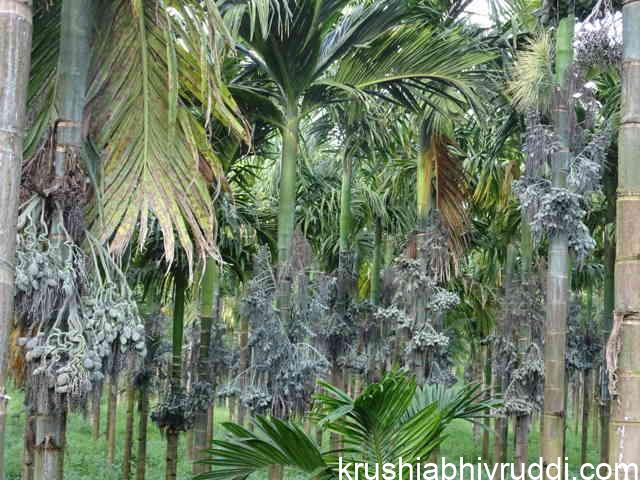Any crop can reap the expected return when it is grown in a suitable environment and locality. Any farmer who would like to grow areca nut should take care of this. After growing the crop farmer should get a good return, otherwise, it is economically not worth it.
- Areca nut is a high-income cash crop grown in the southern states and northeastern states of our country. In South India, Karnataka is the major state growing areca nut for centuries back. In Northeastern parts Assam, Mizoram, and West Bengal are the countries growing this in small quantity. Now because of its price advantage other states like Tamil Nadu, Andra Pradesh, and West Bengal Sikkim, Assam, and Mizoram also started to grow this on a large scale. In Traditional belts, farmers are experts in cultivation practices. Farmers in newly introduced areas do not have much knowledge about this crop. This is an attempt to give information about how to grow this crop and what are the basic requirements for those who are interested in growing.
- Aracanut palm life is around 50 years. It will start yielding only after 5th year of planting. It will be propagated by seeds only.
- The procedure is to germinate the seed nuts in bed and raise the seedling directly in the field.
- Direct seed planting is not in practice.
- Raising the seedlings by selecting seed nuts.
- Any other vegetative propagation is not economical.
- Almost all areca nut plantations are from seeds collected from the selected mother tree.
- The true seed production technique is used only for research purposes.
- Farmers can also produce true seeds with proper training.
- But it is still not in practice. The true seed will give the true character of the mother plant.
- The original areca nut plantations were located in some valley-like areas around Ratnagiri in Maharashtra.
- After that, it has spread to other places.
- In Karnataka too, it is said that some farmers who migrated from Maharashtra have planted this for their Tambula chewing purpose.
- Generally, it was spread to local farmers.
- Migrated Maharastra farmers especially Chitpavanas planted this in valley-type and riverbank areas.
- Initially, there was no vast market for this, but gradually the market grew for it.

Ideal Place for Planting:
- Suitable Land selection for areca nut plantation is very important.
- The land which is closed at the south and west side is very important.
- If it is open the plants will not resist the sunlight of that direction.
- It will damage the trunk and leaf in summer.
- If it is open in this direction we have to plant shade trees in the same direction.
- If the soil is high sand content it is also not suitable.
- Here the root grub problem is high. Red soil with good drainage is suggested.
- The roots of the plant should need proper ventilation.
- So that black clay soil was avoided.
- Planting coconut trees on the south side will protect the areca nut plants permanently.
- When the plantation is raised in a suitable locality, it will withstand drought conditions and excess temperature.
- Arecanut plants have only surface roots.
- These are spread in the upper layer of soil. Roots will emerge in the lower nodes of the plant.
- So loosening of soil is very essential.
- Some farmers plant the seedlings in pits.
- Some plants are in shallow land. Both are good.
- If planting in a deep pit proper drainage is very important.
- Otherwise, plant roots will damage by waterlogging.
- Water logging or water stagnation will cause root rot and plants will die.

Soil Factor:
- It is a very important thing when we go for plant areca nut.
- If it is sandy soil, it is not recommended for areca nut cultivation.
- In this type of land, the root grub damage is high.
- In black cotton soil, soil aeration is difficult.
- Fertile soil with good humus content having 30:70 sand and soil content is good for areca nut cultivation.
- In Summer soil should hold water, In the rainy season draining excess water is very important.
- Laterite soil is found to be good.

Temperature:
- Arecanut plants and trees will not tolerate high temperatures (above 350C).
- The minimum temperature is not below 40 Celsius.
- Soil fertility is also very important.
- If it is less fertile the water holding capacity is less.
- If the temperature exceeds the pests problems like mites are severe.
- The sun scorches to stem and leaf will hinder the growth and yield.
- Rainfall is also very important. A minimum of 750 mm of rainfall is essential.
- Irrigation is a must in the summer and winter seasons.
- In Dry weather conditions, inflorescence dies back and nut falling is noticed.
- Because of sunburn stem cracking takes place and the life span of the plant will decrease.
- If the stem is injured in the initial stage, it will not give yield even for 10 years.
Arecanut plants will give yield more than 50 years. If land and temperature are not favorable its life span will be reduced to 20-25 years. So farmers can concentrate on major factors like ideal land and temperature.











